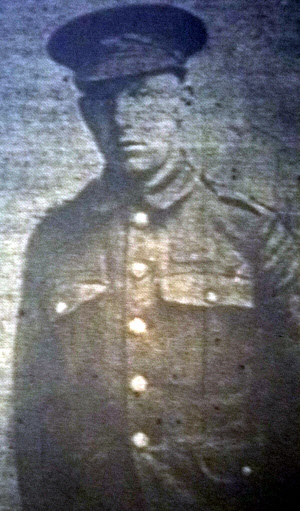
Harry Asquith was born on the 1st June 1888, the son of William and Ellen (nee Dunford, formerly Walton) and was baptised at South Ossett Christ Church on 8th July 1888. William Asquith married widow Ellen Dunford in the December quarter 1873. Ellen had previously been married, when she was aged 16, to Frederick Dunford in September quarter 1862. Frederick died a year later. Ellen Asquith died in September quarter 1889, aged 43.
In 1891 Harry, aged 2, is living in his grandparents’ home at Coxley with his widowed father, William and two siblings Hettie (born 1880) and John William (born 1886). By 1901 Harry is living at Healey, Ossett with his widowed father William, a coal miner and Harry’s brother John William, who is working as a trammer in a coal mine.
By 1911, Harry is living with his 64 year-old widowed father, William, in a two-roomed house at South Street, Ossett. Father and son were both coal miners.
Harry Asquith married Annie Pollard in Ossett in 1912 and they had two children . Jack Asquith (born 1913) and Mary Asquith (born 1915), both in Ossett. Annie (23) died in 1915, probably as a result of complications during the birth of her daughter Mary since both the birth and the death are registered in the same quarter. Harry’s life was marked by tragedy. He lost his mother when he was aged 2, his wife when he was 27 with 2 young children and his own life when he was aged 29.
The 6th (Service) Battalion of KOYLI was formed on the 12th August 1914 at Pontefract as part of the First New Army (K1) and then moved to Inkerman Barracks, Woking to join the 43rd Brigade of the 14th Division. In November 1914 they moved to Witley and in February 1915 to Aldershot. On the 21st May 1915 the battalion was mobilised for war and landed at Boulogne and were engaged in various actions on the Western Front.
From the KOYLI 6th Battalion was diaries:
“The 6/KOYLI were in the front line on 11th October 1917 from Reutelbeke in the south to Polygonbeke in the north. X and Z Companies in the front line and W and Y in support at Jerk House, halfway between Black Watch Corner and Cameron House, where BHQ was situated. Total effectives 300. Battalion was relieved on night of 15/16th October, having suffered 50 casualties mainly from shell-fire, and rested for 24 hours at Ridgewood Camp.
On 17th October the Battalion was a Bedford House supplying carrying parties to the front line. In support line 21/22nd October. Relieved on the night of the 23/24th the Battalion marched to Scottish Wood Camp near Dikkebusch the back to Berthen by lorry. Back to Scottish Wood Camp on 30th October to supply working parties building roads and trench tramways. On 9th November to La Roukloshille then on 13th November to Wizernes via Caestre for intensive training.”
Harry Asquith died on the 16th October 1917 aged 29 years from wounds caused by an enemy shell in the fighting associated with the first and second Battles of Passchendaele.
The “Ossett Observer” 1 had this short obituary for Private Harry Asquith:
“News was received on Tuesday of the death of Private Harry Asquith, of the King’s Own Yorkshire Light Infantry, whose home was King’s Yard, Healey, Ossett. In a letter to his brother, the sergeant of his platoon says that he was killed by an enemy shell on the 10th inst. during a heavy bombardment. The writer added, ‘There is no-one more sorry than the sergeants of his company, as he used to be in with us, both in and out of the line, and we found him one of the best and quietest men I have ever had with me, both a brave man and one you could rely on for carrying out his duties.’ The deceased soldier, who was a widower, with two young children, was previous to joining the army in the employ of Mr. Godfrey Illingworth, farmer and fellmonger.”

Above: The mud of Passchendaele in October/November 1917.
Private Harry Asquith is buried at grave reference LXI. G. 16 at the Tyne Cot Cemetery 3, Zonnebeke, West-Vlaanderen, Belgium. Tyne Cot Cemetery is located 9 Kms north-east of Ieper town centre, on the Tynecotstraat, a road leading from the Zonnebeekseweg (N332).
‘Tyne Cot’ or ‘Tyne Cottage’ was the name given by the Northumberland Fusiliers to a barn which stood near the level crossing on the Passchendaele-Broodseinde road. The barn, which had become the centre of five or six German blockhouses, or pill-boxes, was captured by the 3rd Australian Division on 4 October 1917, in the advance on Passchendaele.
One of these pill-boxes was unusually large and was used as an advanced dressing station after its capture. From 6 October to the end of March 1918, 343 graves were made, on two sides of it, by the 50th (Northumbrian) and 33rd Divisions, and by two Canadian units. The cemetery was in German hands again from 13 April to 28 September, when it was finally recaptured, with Passchendaele, by the Belgian Army.
Tyne Cot Cemetery was greatly enlarged after the Armistice when remains were brought in from the battlefields of Passchendaele and Langemarck, and from a few small burial grounds.
There are now 11,956 Commonwealth servicemen of the First World War buried or commemorated in Tyne Cot Cemetery. 8,369 of the burials are unidentified but there are special memorials to more than 80 casualties known or believed to be buried among them. Other special memorials commemorate 20 casualties whose graves were destroyed by shell fire. There are 4 German burials, 3 being unidentified.
References:
1. “Ossett Observer”, 27th October 1917